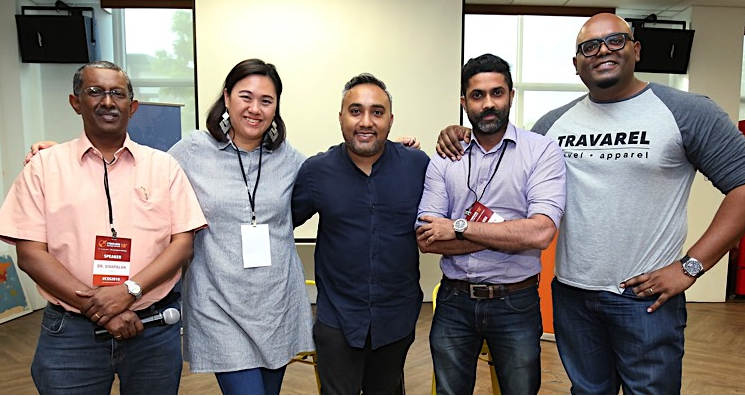Traveltech: Asians never say no to a good bargain
By Kiranjit Kaur Sidhu June 21, 2018
- Opportunities in post-trip traveller experience and B2B landscape
- Challenges include slow adoption and lack of reception from travel industry

“WHILE the American traveltech market is leading in terms of the number of deals and amount of funds raised, half of the most active investors in the world are looking outside of the US,” says Dr Sivapalan Vivekarajah, the cofounder of Proficeo and president of Malaysian Business Angel Network (MBAN), during the traveltech panel at the Cyberjaya Startup Summit 2018.
The panel, moderated by Dr V Sivapalan, was titled Traveltech, Where is it Heading? and the speakers were Stacey Lee, regional growth director of Triip.me, Aaron Sarma, the founder and CEO of Vidi (formerly Touristly), Parthiven Shan, the founder and CEO of Tripcarte.asia and Ija Mohan, the founder and CEO of 3ciety, an online travel apparel company, venturing into travel apparel with Travarel.
Commenting on the changes in the travel industry, Stacey says “Nowadays, people rather spend money on experiences instead of just trips.”
She also notes that many people prefer to plan their own trips instead of relying on tour agencies. Triip.me caters to this demand by allowing travellers to book accommodation and tours by local people.
Aaron shares a similar view, “People want to capture unusual and extraordinary experiences to post on Instagram.”
For example, conventional five-star hotels are facing competition from Vidi, which is a visual discovery platform that eases itinerary planning and booking of holidays. Aaron also says that the demographic of travellers is changing. “Because of cheaper flights by low cost airlines such as AirAsia, more and more people aged between 20 and 30 are travelling.”
Another prominent trend on the rise is the increase of independent travellers. “Chinese tourists are using regional traveltech platforms such as ours to plan trips rather than opting for a physical tour guide,” Aaron says.
Since tourism is a huge contributor to gross domestic product (GDP) within the Southeast Asian region, there is immense opportunity for the growth of traveltech within this region.
Ija shares, “Most companies focus on monetising the pre-trip and on-trip aspect of travel.” He explains that post-trip, travellers are underserved and their experience is neglected.
While some service providers may follow up with a survey form or thank you note, Ija hopes to do something more meaningful. He is working on an online apparel platform, Travarel, to connect people to their experiences through personalised merchandise.
“We want to encapsulate experiences so that the products you take home from your travels tell a story,” Ija says.
Whether the souvenir is crafted by a local designer or displays the street name where the traveller stayed, Travarel aims to give travellers more than just generic and commercially produced souvenirs.
In addition to post-trip opportunities, Aaron also highlights the potential in the B2B of traveltech. “People often think of B2C solutions where they’d have to compete with giants. But there is a lot of opportunity in the background.”
He draws attention to Agoda and Booking.com which are linked through an aggregated inventory of hotels and accommodation.
Considering the impending boom of tech such as blockchain, augmented reality (AR) and virtual reality (VR), the best in traveltech is yet to come.
Triip.me is already looking to introduce TriipMiles, a loyalty point platform using a decentralised blockchain network of smart contracts, to allow customers to redeem packages on the platform.
As for VR, it will most likely serve to enhance customer experience in selecting their accommodation of choice. “Before customers book luxury hotels, they will be able to have a closer and more realistic feel with the help of VR,” Stacey shares.
Artificial intelligence and machine learning will also impact traveller convenience. “By harnessing data of your preferences and dislikes in hotels, activities and flights, online platforms will be able to plan your perfect trip for you,” Stacey adds.
However, the journey to better traveltech is paved with challenges. Parthiven notes, “There are still lots of things to be improved in the whole travel process.”
Tripcarte.asia is an online ticketing platform for tourist attractions and he notes that the ticketing system is slow to evolve, “A lot of places still require you to print a physical ticket which should not be the case in today’s world.”
Additionally, there are also challenges in the adoption rate of traveltech among travellers in the region. When Tripcarte.asia first started in Langkawi in 2015, there was a lot of friction between local travel agents and online agents.
“With the issue of small profit margins, the travel industry tends to look at online travel agents as competitors rather than strategic partners,” Parthiven says.
However, he adds that traveltech has the potential to enable local experience providers such as fishing villages and farmers since travellers are constantly seeking the unique.
However, to overcome slow adoption rates, Aaron believes that platforms which give Southeast Asian travellers good bargains will have little issue. “When there’s a price component involved, Asians never say no to discounts.”
Related stories:
Impact travel platform Triip.me to expand scope with Booking.com partnership
Touristly deepens its hooks into AirAsia customers with travel3sixty digital
Amadeus’ Navitaire unveils virtual reality travel search and booking experience
For more technology news and the latest updates, follow us on Facebook, Twitter or LinkedIn


